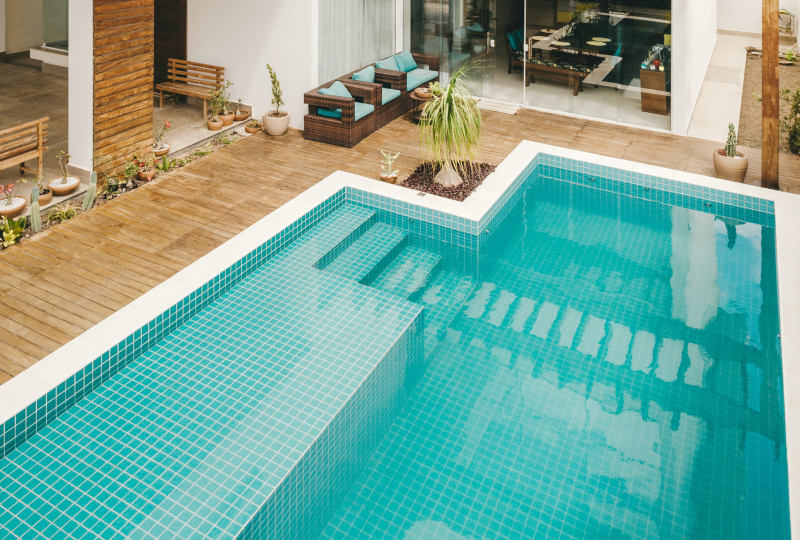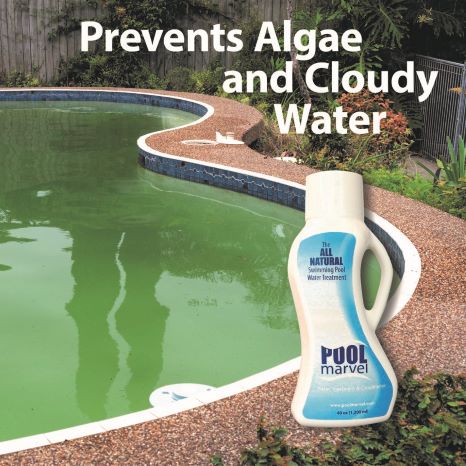
Pool Shock
Pool shock chemicals play an important role in pool water maintenance. Adding a shock product to pool water increases the level of free chlorine so that contaminants such as algae and bacteria are destroyed, making the water safe for use.
The best pool shock treatment and frequency of shocking depend on several factors, such as the number of swimmers who use your pool and the weather and temperature outdoors.
What Is Pool Shock?
Pool shock is a chemical that removes contaminants and sanitizes pool water using oxidization. A chlorine or non-chlorine product breaks up combined chlorine, or chloramines, during a shock treatment. Chloramines form when chlorine mixes with contaminants, creating the strong, undesirable chlorine smell found in some pools. Chloramines aren’t effective at breaking down harmful bacteria and indicate improperly sanitized water.
Besides removing chloramines from pool water, pool shock is used to get rid of excess bather waste and bacteria after heavy pool use, remove visible algae growth, and clear up cloudy pool water.
What Does Pool Shock Do To A Pool?
Shocking your pool destroys the undesirable, foul-smelling chloramines while increasing the amount of free chlorine. A shock treatment will usually increase the free chlorine level to 5-10 ppm.
When using pool shock, the goal is to reach the breakpoint chlorination level – or the point where there’s enough free chlorine to break up chloramines. Usually, ten times the amount of combined chlorine must be added to reach the threshold of breakpoint chlorination and remove chloramines, algae, and pathogens from the water.
Reasons To Shock A Pool
There are typically three main reasons to shock a pool:
Chloramines
Polymer pool algaecides, also known as polyquat algaecides, feature long carbon chains that attach to algae, spread over the surface, and smother the cell. Although polyquats are more expensive than other quat algaecides, they’re effective at destroying stubborn algae blooms without causing staining or foaming.
Polymer algaecides are among the top active algaecides and are commonly available in 40 and 60 percent concentrations.
Copper-Based Algaecides
When chloramines or the combined chlorine level increases to more than 0.5 ppm, add enough shock to break apart the combined chlorine. This usually requires 10-20 times the tested combined chlorine level.
Algae
Chlorine is one of the best algaecides to use against active green, yellow, and black algae blooms.
Adjusting the pH to 7.1-7.3 makes chlorine shock the most potent. Severe algae blooms may require enough pool shock to reach 30 ppm. To destroy light-coloured or isolated algae, only 10 ppm is usually needed.
Bacteria and Bather Waste
Swimmers can introduce numerous pollutants into your pool like sunscreen, body oil, make-up, urine, and sweat. Hosting a pool party or having extra bathers places additional strain on chlorine levels and typically requires a shock treatment.
Environmental factors like leaves, dust, pollen, and bird droppings can do the same. These contaminants use up chlorine and make the water cloudier. Periods of extreme heat can also affect a pool’s chemistry.
Other Reasons to Shock a Pool
Contaminants and ground runoff can enter your pool during heavy rainfall and high winds. Rainwater often increases the pH, which affects the effectiveness of chlorine.
You should also shock your pool after a significant water level change or if there’s excrement in your pool.
Shocking your pool at start-up after the chemistry is balanced helps oxidize particles, remove contaminants, and clear up cloudy pool water. At the end of the season, use pool shock to disinfect the water and prepare for the winter ahead.
When To Shock A Pool
The best time to shock a pool is at night when the sun’s UV rays won’t affect the shock chemicals.
Determining how often to shock a pool depends on your particular situation. If you’ve recently hosted a gathering for a large number of swimmers, or if your pool becomes contaminated, you should complete a shock treatment.
Throughout the swimming season, you should shock your pool every 1-2 weeks to help maintain a healthy pool. If you test your pool water and find that the chlorine is outside the recommended range of 1-3 ppm, it may be time to shock your pool.
Shocking needs to occur when there are no swimmers in the pool. After completing a shock treatment, you’ll need to wait a certain period of time before swimming again. It’s safe to swim again when the free chlorine level falls below 5 ppm.
Types Of Pool Shock
There is a variety of chlorine and non-chlorine pool chemicals available to use for shocking your pool:
Calcium Hypochlorite
Calcium hypochlorite, also known as cal hypo, is one of the most popular and strongest chlorine shock products. Normally offered in a granular form, cal hypo requires dissolving before it can be added to pool water. It’s available in two strengths and can kill algae and bacteria while removing chloramines and ammonia.
Commercial versions of calcium hypochlorite typically contain 65-75 percent chlorine. Every ppm of free chlorine added increases calcium by approximately 0.8 ppm.
Advantages:
Economical to purchase and convenient to use.
Disadvantages:
Raise your pool water’s calcium level and can cause bleaching, fading, or corroding of vinyl or painted surfaces. It requires a more extended waiting period, has a strong odour, and is more hazardous to store than non-chlorine shock.
Lithium Hypochlorite
Since it doesn’t increase the water’s calcium level, lithium hypochlorite is a good chlorine shock option for pools with a high calcium level.
Convenient to use, this chemical is added directly to the pool, where it quickly dissolves. Its commercial versions contain 35 percent chlorine.
Advantages:
Dissolves quickly; can be added directly to pool water without pre-dissolving.
Disadvantages:
Expensive and can be difficult to source due to the rising cost of lithium. Because it’s toxic to aquatic life, extra care is needed when disposing of recently treated water.
It is not nearly as strong as Calcium hypochlorite.
Dichlor
Dichlor is the safest and easiest chlorine shock product to use. Containing between 50-60 percent chlorine, Dichlor can be used for both regular chlorine doses and shock treatments. Every ppm of free chlorine adds 0.9 ppm of cyanuric acid.
Advantages:
Doesn’t usually require dissolving before use. It doesn’t add calcium to the water, making it suitable for pool owners concerned about increasing calcium hardness levels.
Disadvantages:
Adding too much cyanuric acid can reduce the effectiveness of chlorine.
Non-chlorine shock
Potassium peroxymonosulfate is an inexpensive, non-chlorine shock. Unaffected by sunlight, it can be added directly to your pool water at any time – not just after dusk.
Because it’s fast-acting, swimmers only need to wait 15 minutes after the product is used before swimming can resume. Since it doesn’t utilize chlorine, it’s ineffective against algae or bacteria.
Advantages:
Non-chlorine shock creates no leftover dusty residue, odour, or cloudiness in the water. It’s convenient to use since no pre-dissolving is needed. Swimming can commence almost immediately after its use, which is helpful in pool emergencies.
Disadvantages:
Non-chlorine shock isn’t as effective against algae or bacteria as chlorine shock.
How To Shock A Pool
1. Clean the pool
Remove leaves and other debris from the pool.
2. Test the Water
Complete a pool water test to check the chlorine, pH, and alkalinity levels. To make the shock treatment more effective, balance your pH so that it’s between 7.4-7.6 and your alkalinity is 100-150 ppm.
3. Calculate the Amount of Shock
Put on protective eyewear and chemical-resistant gloves. Follow the manufacturer’s directions to calculate the shock you’ll need to mix. If you need to dissolve the shock first, fill a five-gallon bucket roughly three-quarters full with warm water. Using one-pound increments, add the shock to the bucket. Carefully stir until the product is dissolved.
A liquid pool shock product can be added directly to your pool water.
4. Add Pool Shock to Water
Walking around the edges of your pool, slowly pour the shock mixture into the water. If there are solid particles at the bottom of your bucket, dip the bucket into the water, stir to dissolve them, and continue pouring.
Operate your pool pump and filter at full speed to help distribute the shock more effectively. Keep the pump operating for at least 8-12 hours.
5. Re-Test the Water
Recheck your pool chemistry and balance accordingly. Wait for the free chlorine levels to drop to at least 5 ppm before using the pool. Otherwise, you may experience eye and skin irritation or bleached swimwear.
How Long After You Shock A Pool Can You Swim?
The length of time you must wait to swim after shocking a pool depends on the shock used. In general, waiting up to 24 hours is recommended.
Before anyone gets back into the pool, test the water to ensure the free chlorine levels are at or below 5 ppm.

How To Shock A Saltwater Pool
Shocking a saltwater pool is no different than shocking a regular chlorine pool. A shock treatment is recommended every couple of weeks and every week during heavy rain and/or high usage.
You may have the option of shocking your saltwater pool using a super chlorinate button on your saltwater generator.
How long to wait after shocking a saltwater pool before swimming is similar to traditional pools – often at least 12 hours and as much as 24 hours. Test the chlorine level to ensure it’s at a safe level before resuming swimming activities.


